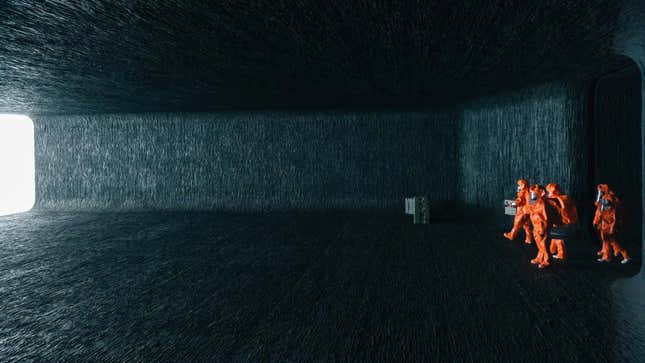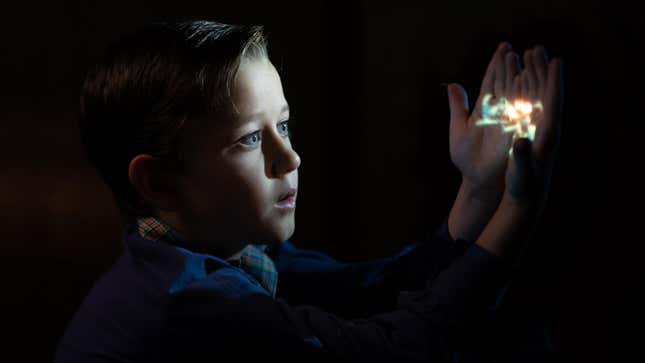
We’ve all been there. You tune into a show, often something in the fantasy or sci-fi genre, and you end up squinting at the screen because you can hardly make out what’s happening. Game Of Thrones is a notorious repeat offender (the season-eight episode “The Long Night” is often cited as one of the most egregious examples of this), but it’s not the only show or movie doing this. From The Batman to Daredevil to Ozark to The Mandalorian, the same complaints come up again and again. Is this a creative trend, the result of technical advances, or just bad filmmaking? We reached out to some experts for answers, and while it turns out to be a combination of all three, it seems that viewers also share some of the blame for the way they’re watching this content on their home screens.
“Where does the responsibility lie?” ponders cinematographer and colorist (or colourist, since he’s Canadian) Devan Scott. If you read his Twitter feed (@SadHillDevan), it’s full of keen observations on modern and historic cinema, but we were particularly interested in his take on the increasingly pervasive dark aesthetic. “Because, you know, Arrival is often seen as one of the major works in this kind of—I mean, I’m making up this term—New Darkness movement. Bradford Young, the cinematographer of Arrival, is probably one of the most controversial figures in this field. He also shot Solo, which is often brought up as a particularly dark film. If you watch Arrival in a cinema it looks great. I mean, assuming it’s a well-calibrated projector, it looks fantastic. But watch it at home in a bright room, it’s almost illegible. And I think it’s totally Bradford Young and [director] Denis Villeneuve’s right to make a film designed for cinema viewing, especially in the pre-pandemic era when cinemas were still in business. But then you have something like that one episode of Game Of Thrones, right? Where that is probably the single thing that’s brought up most. And I think you have a whole lot of things combining there. It was like a perfect storm.”

Paul Maletich, a digital imaging technician whose resume includes films like Blade Runner 2049 and Collateral as well as TV series like You and Mayfair Witches, agrees that the darkness we’re seeing is a deliberate decision on the part of creators. “It’s an artistic choice, absolutely,” says Maletich, whose job is to make sure everything is captured properly on set and to color the raw feed before it goes to post-production. “Sometimes the filmmakers don’t want you to see everything. If you catch just a cheek or you catch an eyelid, maybe that’s all they want you to see. You don’t have to see the entire face. It is intentional. Is it intentional 100 percent of the time? No, of course not.”
Entering the dark ages
Why do filmmakers do this if it makes their work harder to see? The short answer is because they can. In the days of 35mm film, directors had to ensure they captured everything on set as they were shooting. Their ability to adjust the image was extremely limited. Some notable cinematographers experimented with light and shadow—like Gordon Willis, whose shadowy cinematography for films like The Godfather earned him the nickname “The Prince of Darkness”—but generally everything was much brighter in days gone by. That all changed when digital cameras came onto the scene.
Scott sums it up this way: “What do artists do when presented with the new toolkit? They’re going to use it. But that’s also not inevitable, right? It’s a trend enabled by tools, but not made inevitable by them.”
Although the industrywide transition to digital was well under way by the time the Arri Alexa camera came out in 2010, its advanced sensor and image processing took digital filmmaking to a whole new level. With this new technology creators could produce a higher quality picture, and had more control over the final look of the film, and everyone wanted to try out the newest toys. Alexa quickly became the industry standard, but it wasn’t until the 2016 film Arrival—shot with the Alexa—that the dark aesthetic became really popular. You can credit (or blame, depending on your perspective) Villeneuve and Young for kicking off the trend in spectacular fashion, but even before that films like 2012’s Zero Dark Thirty were showing off what the camera could do in low light.
“I think that oftentimes we just straight up underrate artistic trends,” Scott says. “Those are two just large examples of very dark scenes that made a big impact on, for example, my generation of cinematographers. Everyone was talking about Arrival for a while and so those made an impact. I mean, I got asked, ‘How do I make my film look like Arrival?’ for two years.”
There’s one final factor that is contributing to poor image quality for viewers who watch content streaming: compression. In order to efficiently transmit the original video feed, which contains a massive amount of data, some information has to be stripped out before it gets to your screen. This process is automatically handled by an algorithm that’s basically just guessing what parts of the picture are important. It’s not as noticeable when an image is brightly lit, but dark scenes present more of a challenge for these automated processes.

Fighting darkness with darkness
This “New Darkness” movement, as Scott calls it, isn’t going anywhere for now. That leaves it up to the audience to ensure they have ideal viewing conditions in place in their own homes. There are two main variables at play here—your environment and your TV screen. Not everyone is able to make all of these adjustments, but even small changes can improve the quality of your picture.
The first and easiest thing viewers can do is create an environment as close to the one the director and cinematographer intended, whether that’s a movie theater or a darkened room in your home.
“Something mainstream, like a CSI, those you will always see because the studio dictates it,” Maletich says. “And they know that not everyone’s TV is the same and not everyone has the same viewing room. You know, some people watch TV in a room that has windows all around it. Other people watch TV in a closet. So your viewing room also has something to do with it. Our TV is in a room that’s dimly lit with curtains. And I have my television at home calibrated, because sometimes I have to watch dailies here at the house. So I need to make sure that what I’m looking at is almost as good as what I see on set.”
Consider limiting the amount of light in the room where you’re watching. Close your curtains or blinds whenever possible, and keep light sources to a minimum. That’s how people used to watch films—in darkened cinemas where the only source of illumination was the screen.
“Back in the day, and by back in the day I mean long before I was born, cinemas were basically perfectly dark spaces, because there was no such thing as exit signs,” Scott says. “You didn’t have that. So, back when cinemas were perfectly dark spaces, you could, theoretically, have an extremely dark film that audiences’ eyes would adjust to. There are other reasons why you wouldn’t do that, but you could. And now cinemas have changed. Now we actually have, you know, mostly legally required zones of brightness that anchor the audience’s eyes, right? I mean, for good reason. I mean, I’m all for fire escapes. But then when we get into home viewing, it gets really, really gnarly, right?”
Do touch that dial: changes that (might) help
The other variable you have control over as a viewer is your home TV screen. There are lots of helpful calibration tools out there—including DVDs and YouTube videos like the one above and this one—that will help you find the right display settings for even the darkest scenes. Some of the instructions you’ll find online get super technical, but we like this simple list of tips from journalist and author Neil Miller of Film School Rejects and One Perfect Shot. Here’s what he recommends:
- Turn off motion smoothing. This is the setting Tom Cruise calls “the soap opera effect.” Different brands have different names for it—LG calls it “TrueMotion,” on a Sony TV it’s “MotionFlow,” or “Auto Motion Plus” on a Samsung. If you’re not sure what it’s called on your TV, try searching for your make and model online. Listen to Tom and turn that shit off.
- If your TV has a feature called “Movie Mode,” or “Cinema Mode,” or “Filmmaker Mode,” that’s one you want to turn on. It will automatically set the brightness and contrast for you, but you can usually still adjust them manually if the result isn’t to your liking.
- Turn up the contrast, but not too high. You want a significant difference between black and white, but if you push it too far you’ll get blown-out brights and lose some of the detail in the darkness.
- Do not be tempted to turn up the brightness. Keep it at around 50 percent.
- Check your color temperature setting. If it’s set to “cool,” which is often the factory setting meant for displaying TVs in a brightly lit retail space, change it to “warm.”
- If your TV has an automatic light sensor or power saving mode, turn that off too.
This should help you make out those dark scenes if you’ve been having trouble seeing them properly. We’re not totally letting filmmakers off the hook for pushing the limits of what the average viewer can see, but as long as this aesthetic remains in vogue, it’s going to be on us to compensate for it. Only time will tell whether this is a fleeting trend or a more permanent evolution. Maybe some innovative cinematographer will come along and do some amazing things with light and color and before long we’ll be talking about how everything has become too bright. Until then, we’ll have to learn to live with the darkness.